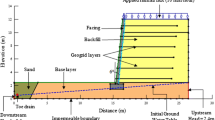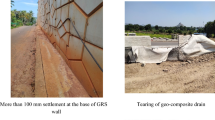Abstract
Reinforced soil walls are cost-effective alternatives to earth-retaining structures which can accommodate more settlements than conventional retaining wall systems. Ideally, freely draining granular materials such as sand are used as the backfills. But, scarcity of ideal granular materials necessitated the researchers to explore other alternatives. A large quantity of construction and demolition waste (CDW) is being generated in India as well as in other parts of the world. In this study, the feasibility of using CDW as a backfill for geosynthetic-reinforced soil walls has been attempted. The geotechnical properties of CDW were determined in order to ascertain whether their properties comply with existing specifications. It was observed that the geotechnical properties of CDW meet the requirements of an ideal backfill material for MSE walls mandated by various standards. Further, the numerical studies were conducted to study the deformation behavior of reinforced soil wall with CDW backfill immediately after construction. The assumptions made in the conventional design regarding the failure mechanism were also investigated. The paper highlights the potential use of processed CDW as a sustainable backfill material for reinforced walls.












Similar content being viewed by others
References
Koerner RM, Koerner GR (2011) The importance of drainage control for geosynthetic reinforced mechanically stabilized earth walls. J Geoeng 6(1):3–13
Christopher BR, Elias V (1997) Mechanically stabilized earth Walls and reinforced soil slopes design and construction guidelines (No. FHWA-SA-96-071). Federal Highway Administration
National Concrete Masonry Association (2010) Design manual for segmental retaining walls. National Concrete Masonry Association
Pant A, Datta M, Ramana GV (2019) Bottom ash as a backfill material in reinforced soil structures. Geotext Geomembr 47(4):514–521
Prasad PS, Ramana GV (2016) Feasibility study of copper slag as a structural fill in reinforced soil structures. Geotext Geomembr 44(4):623–640
CPCB (2017) Guidelines on environmental management of construction & demolition (C&D) wastes (prepared in compliance of rule 10 sub-rule 1(A) of C&D waste management rules, 2016)
Vieira CS, Pereira PM (2015) Use of recycled construction and demolition materials in geotechnical applications: a review. Resour Conserv Recycl 103:192–204
Santos ECG, Palmeira EM, Bathurst RJ (2013) Behaviour of a geogrid reinforced wall built with recycled construction and demolition waste backfill on a collapsible foundation. Geotext Geomembr 39:9–19
Santos ECG, Palmeira EM, Bathurst RJ (2014) Performance of two geosynthetic reinforced walls with recycled construction waste backfill and constructed on collapsible ground. Geosynth Int 21(4):256–269
Nawagamuwa UP, Madarasinghe DL, Goonatillake MD, Karunarathna HJ, Gunaratne M (2012) Sustainable reuse of Brownfield properties in Sri Lanka as a gabion fill material. In: ICSBE-2012: international conference on sustainable built environment Kandy, Sri Lanka
Rahman MA, Imteaz M, Arulrajah A, Disfani MM (2014) Suitability of recycled construction and demolition aggregates as alternative pipe backfilling materials. J Clean Prod 66:75–84
Suluguru AK, Surana SR, GuhaRay A, Kar A, Muktinutalapati J (2019) Experimental investigations on building derived materials in chemically aggressive environment as a partial replacement of soil in geotechnical applications. Geotech Geol Eng 37(2):947–963
Arulrajah A, Piratheepan J, Aatheesan T, Bo MW (2011) Geotechnical properties of recycled crushed brick in pavement applications. J Mater Civ Eng 23(10):1444–1452
Vieira CS, Pereira PM (2017) Use of mixed construction and demolition recycled materials in geosynthetic reinforced embankments. Indian Geotech J 48(2):279–292
Cardoso R, Silva RV, de Brito J, Dhir R (2016) Use of recycled aggregates from construction and demolition waste in geotechnical applications: a literature review. Waste Manag 49:131–145
Soleimanbeigi A, Tanyu BF, Aydilek AH, Florio P, Abbaspour A, Dayioglu AY, Likos WJ (2019) Evaluation of recycled concrete aggregate backfill for geosynthetic-reinforced MSE walls. Geosynth Int 26(4):396–412
Arulrajah A, Rahman MA, Piratheepan J, Bo MW, Imteaz MA (2013) Interface shear strength testing of geogrid-reinforced construction and demolition materials. Adv Civ Eng Mater 2(1):189–200
BS-8006 (2010) British Standards. Strengthened/reinforced soils and other fills
AASTHO (2002) American Association of state highway and transportation officials. Interims to standard specification for highway bridges, sixteenth edition. AASTHO, Washington
SCDOTGDM (2010) South Carolina department of transportation geotechnical design manual
IRC: SP: 102 (2014) Guidelines for design and construction of reinforced soil walls. In: Indian Roads Congress
ASTM D6913(2009) Standard Test Methods for Particle-Size Distribution (Gradation) of Soils Using Sieve Analysis. ASTM International
ASTM D4972 (2001) Standard test method for pH of soils. ASTM International
IS 2720-Part 21 (1987) Methods of test for soils: determination of total soluble solids
ASTM D698 (2012) Standard test methods for laboratory compaction characteristics of soil using standard effort. ASTM International
Parsons AW (1992) Compaction of soils and granular materials: a review of research performed at the Transport Research Laboratory. HM Stationery Office, ISBN-0115510915
ASTM D4253 (2000) Standard test methods for maximum index density and unit weight of soils using a vibratory table. ASTM International
ASTM D4254 (2006) Standard test methods for minimum index density and unit weight of soils and calculation of relative density. ASTM International
ASTM D3080 (2011) Standard test method for direct shear test of soils under consolidated drained conditions. ASTM International
Vieira CS, Pereira PM, de Lurdes Lopes M (2016) Recycled construction and demolition wastes as filling material for geosynthetic reinforced structures. Interface properties. J Clean Prod 124:299–311
TIFAC (2001) Utilisation of waste from construction industry. TMS 150, environment and habitat. Technology information, forecasting and assessment council
Hatami K, Bathurst RJ (2005) Development and verification of a numerical model for the analysis of geosynthetic-reinforced soil segmental walls under working stress conditions. Can Geotech J 42(4):1066–1085
Allen TM, Bathurst RJ (2019) Geosynthetic reinforcement stiffness characterization for MSE wall design. Geosynth Int 26(6):592–610
Mirmoradi SH, Ehrlich M (2015) Numerical evaluation of the behavior of GRS walls with segmental block facing under working stress conditions. J Geotech Geoenviron Eng 141(3):04014109
Author information
Authors and Affiliations
Corresponding author
Additional information
Publisher's Note
Springer Nature remains neutral with regard to jurisdictional claims in published maps and institutional affiliations.
Rights and permissions
About this article
Cite this article
Vibha, S., Divya, P.V. Geosynthetic-Reinforced Soil Walls with Sustainable Backfills. Indian Geotech J 51, 1135–1144 (2021). https://doi.org/10.1007/s40098-020-00450-2
Received:
Accepted:
Published:
Issue Date:
DOI: https://doi.org/10.1007/s40098-020-00450-2




